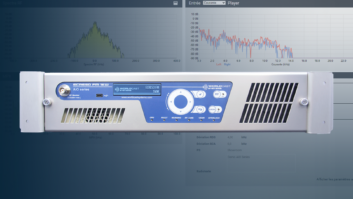The author is an assistant archivist at New York Public Radio.
From The Editor
We continue our recent special series about preserving the history of radio, in conjunction with the Library of Congress’ Radio Preservation Task Force (http://radiopreservation.org).
— Paul McLane
I occasionally have to repeat to myself that “we are fortunate to have such problems.”
WNYC has one of the few active radio station archives in the United States, and one of radio’s richest histories. The station has been running continuously for over 90 years, only a few of them lean, with the Archives joining in for only the last 16. We have three full-time, dedicated staff members, with expertise in information science, audio production and the intertwined histories of New York City and radio, and, with the help of WNYC’s underwriting team, the opportunity to add to that staff for work on other special projects.
We have a seemingly endless supply of historic “hot tape.” In my short time here, I’ve had the pleasure of digitizing recordings featuring “capital-P” poets (Auden), painters (Warhol) and politicians (La Guardia). I’ve uncovered a rare performance by Leadbelly, captured in his final months; transferred Robert Moses’ rawest speeches; and gotten to hear the inimitable Carl Sandburg spin wise on the writer’s craft. It’s clear that even after decades our hottest tape has hardly cooled.
We have the opportunity to reintroduce to the world those recordings through our WNYC.org Archives and Preservation blog. We can also make use of WNYC’s talented Data News team, through whom we’ve built quizzes, maps, “audiograms” and other useful widgets that color our corner of the WNYC web. And we also get to have many of our classics hit the air, both through WNYC’s bi-weekly Thursday morning segment “Way Back,” and in helping reporters and producers, often frazzled and frantic, find archival audio which is then seamlessly integrated into shows and reports that will reach thousands upon thousands of WNYC listeners.
We have it pretty good.

The home page of New York Public Radio Archives. Learn more at www.wnyc.org/series/archives-preservation.SOURCE OF CONFUSION
The “problems” stem from a single word, “series” — a word with many meanings spanning many disciplines — and the confusion it has unleashed upon our archives as we have attempted to maintain a public web presence showcasing our continuing preservation efforts. Again, we are fortunate to have such problems.
“Series” means one thing to archivists — “A group of similar records that are arranged according to a filing system and that are related as the result of being created, received or used in the same activity,” according to the Society of American Archivists 2005 Glossary. It is intrinsically linked to the original record-keeping systems made and maintained by the parent organization — something that approaches a near-sacred value in the world of archives.
“Series” means something else for our in-house catalog, which is based on the public broadcasting metadata schema PBCore — “A group of separate items related to one another by the fact that each item bears, in addition to its own title proper, a collective [series] title applying to the group as a whole …” The word “series” here is maintained as a type of title, and is less clearly a facet of intellectual arrangement. Its main purpose is to facilitate sharing of information with other public broadcasting organizations.
And “series” means still something else for our web developers — a means for producers and other showmakers to arrange content within or across their programs.
That each of these “series” has overlapping meanings, that there are other potential “series” synonyms in play and that there are encroaching colloquial definitions only redoubles our confusion.
That confusion is mostly harmless, until WNYC decides to redesign its website, reworking the look and logic of the station for the eyes and ears of the internet. Then it becomes a “problem,” one we are in the midst of dealing with.
SHOWS VS. SERIES
“Series” in our catalog maps to “show,” “not “series” on WNYC’s website. This is because only “shows” allow us to avoid redundancy by segregating audio pulled from our catalog from pieces that have been written about as features for the Archives blog. This is done through the creation of “Article Channels,” which are themselves muted on the website. “Article Channels,” mind you, can only be made through “shows.” “Series” is the one concept malleable enough (on the website) to allow us to create “collections,” which is a separate field in our catalog and a separate concept in archival arrangement. “Series” (on the website) is thus capable of being conceptually both above (as an archival “collection”) and below (as an archival “subseries”) the website “show” (which is an archival “series”). Whew.
Most of our colleagues have to manage one “show,” and maybe a few “series.” We have dozens, potentially hundreds of “shows” and “series,” and as we delve into our stations past, mining the Municipal Archives’ WNYC Collection as part of our current NEH grant project, we are continuing to add to list. We’ve also made “new” “shows,” (“series” both archivally and in our catalog, ignoring a conceptual tension), based on the activities of “the mayors,” many of whom had an actual “show” of his own. The process of going through laboriously tweaking each “show” would somehow be both tedious and complex, so the more automated the process, the better. The intellectual distinctions are important to maintain, but as you can see, get quite confusing.
WNYC’s website is and should be periodically refashioned to live in a modern world on a modern web. While it should and does give a nod in our direction, WNYC.org audiences are rightfully best served if living media are not crowded out with the hundreds of extinct shows, programs or, yes, “series” WNYC has produced throughout its lengthy history. So the WNYC Archives are quite reasonably subtly segregated from the rest of WNYC’s content, but we must integrate our activity with a website designed for a certain type of modern use, one that emphasizes the new, to present a more fixed historical view of our station’s and city’s history.
Maintaining the public face of radio preservation within a living media organization offers unique challenges as the past and present continually redefine their relationship — and the “series” struggle is but one of many worries. But we are fortunate to have such problems.
Comment on this or any story to[email protected].












